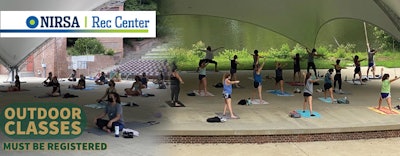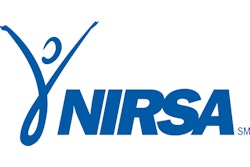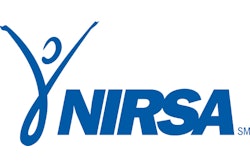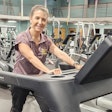
More than a year has passed since the coronavirus pandemic ended traditional campus life by abruptly closing colleges and universities — forcing campus recreation leaders to seek alternative programming options that promoted both wellbeing and social distancing.
"Hybrid is here to stay," wrote Pam Watts, executive director of NIRSA, in the introduction to the organization's latest member survey, "State of Campus Recreation Related to the COVID-19 Pandemic." "With nearly a year of forced experimentation under our belts and a shift in how society is willing or expects to engage, campus recreation has an opportunity to expand its impact on student success. Perhaps these new online or hybrid methods will help us to engage that last segment of students we weren't reaching before."
Representatives from 240 NIRSA member institutions responded to the survey last fall, which was designed to better understand the collective impact of COVID-19 on campus recreation operations. The results indicate most staffs quickly transitioned to a work-from-home model, implemented online staff training and student programming, and increased virtual offerings and esports competitions.
And those strategies worked.
"We've created a much lower barrier to entry and a much more inclusive environment for students to get inspired," says Rod Tucknott, assistant director for Adventure Programs at the University of California, Santa Barbara, which partnered with the National Park Service last fall to offer a series of virtual tours — giving participants an insider's view of such iconic sites as California's Joshua Tree National Park and Channel Islands National Park.
The idea stemmed from similar programming at California State University, Northridge. Campus recreation officials there shared the concept with other institutions, and as Tucknott says, "We dipped our toe in that water and found success with it."
More than 200 students and members of the greater Santa Barbara community participated in the roughly 10 virtual tours, which lasted 30 minutes and included question-and-answer sessions.
"They loved it," Tucknott says. "This was one of those unique things that we don't often get to do in real life. Sure, we visit national parks to hike, kayak, camp and enjoy the wilderness. But it's rare to sit down with an interpretive park ranger and really learn about the park's history and what it means."
UCSB's campus recreation facilities are tentatively scheduled to reopen this spring, but Tucknott is resolute in his commitment to hybrid programming.
"I would like to continue to offer some sort of online element for the foreseeable future — even when we go back to in-person programming," he says. "I think that we have found a certain amount of success, especially with those students who may be intimidated by our adventure programs. Now, they might want to take the next step and do a day hike. So if this becomes a stepping stone to get people to engage in the outdoors, then I can see us offering virtual programs for years to come."
Campfires and art projects
Within 48 hours of shutting down in-person operations last March, campus recreation officials at the College of William & Mary had uploaded video on its fitness and wellness website offering tips on everything from meditation to setting up a tent.
The latter lesson came in handy for those who participated in a weekly series of Friday night campfires and Saturday night campouts. Organized by the Tribe Adventure Program and led entirely by students, the outings took place at various sites in Matoaka Woods. Located on campus, the woods allowed for easy access on foot, and the college provided all of the gear — including hammocks and single-person tents.
"The one thing that students were really missing was that sense of community from being on campus," says Linda Knight, executive director of Health & Wellness at William & Mary. "So this gave them a chance to meet people outside the residence halls in a safe environment. We added a bunch of Adirondack chairs so people could sit around campus, including outside the Bee McLeod Recreation Center, where we held a couple of the campfires. This helped people stay six feet apart with masks on and feel comfortable. We also added lighting to different places around campus, so students could stay out until 1 in the morning, because we knew they didn't want to be stuck in their dorm rooms."
The outings continued throughout the fall semester, and more were organized as word of mouth spread. Friday night campfires also returned for the spring semester, back by popular demand.
"There were a lot of students who had never participated in our outdoor programs before," Knight says. "If you're not comfortable in the outdoors, you don't necessarily want to get in a van and drive somewhere to camp overnight and hike and rock climb, because you just don't have the confidence to do it. But this wasn't nearly as threatening, and they could still be out in the wilderness and receive an introduction to the outdoors."
Like virtual tours of national parks and socially distant weekends in the woods, the "Art Olympics" at Viterbo University aimed to introduce students to a broader palette of campus recreation offerings.
The brainchild of Viterbo senior Christina Repa, who is pursuing a psychology major and art minor, the weeklong initiative last fall featured a series of art projects that included drawing, mandala coloring, string painting and making do-it-yourself candle lampshades. Each participant was entered in a drawing to win gift cards, art supplies and other prizes. The more projects a participant completed, the more chances they had to win.
As a student intern in the university's Recreation and Leadership Department, Repa was tasked with determining the projects, coordinating distribution of supplies and instructions, virtually sharing projects via Microsoft Teams and awarding prizes.
"I just wanted to do something that would promote art as a therapeutic tool, and I feel it had an impact," says Repa, who might continue her education in an art therapy master's program. "Even now, students come up to me and talk about the experience."
"There is a need on campus to find new ways to connect with students and help them connect with each other in the current environment," adds Marci Iverson, director of Recreation and Leadership at Viterbo, noting that 15 students signed up to receive the free art-supply kits. "This program helped our campus community better understand how we engage beyond just traditional recreation activities like fitness."
Optimism abounds
One question in NIRSA's recent survey asked respondents when they thought their own departmental operations and programs might return to a "new normal." Only 17 percent predicted this spring, but 61 percent anticipate it happening by fall 2021, and 80 percent think it will be by spring 2022.
Whenever it arrives and whatever form it takes, the "new normal" should serve as a reminder to campus recreation leaders of how it got here, according to William & Mary's Knight.
"I hope we never have to live through something like this again, and I really hope we don't lose what we're learning," she says. "We've learned new things that are important to our students and how to meet their needs."
This article originally appeared in the April 2021 issue of Athletic Business with the title "How hybrid programming increases student engagement." Athletic Business is a free magazine for professionals in the athletic, fitness and recreation industry. Click here to subscribe.





































